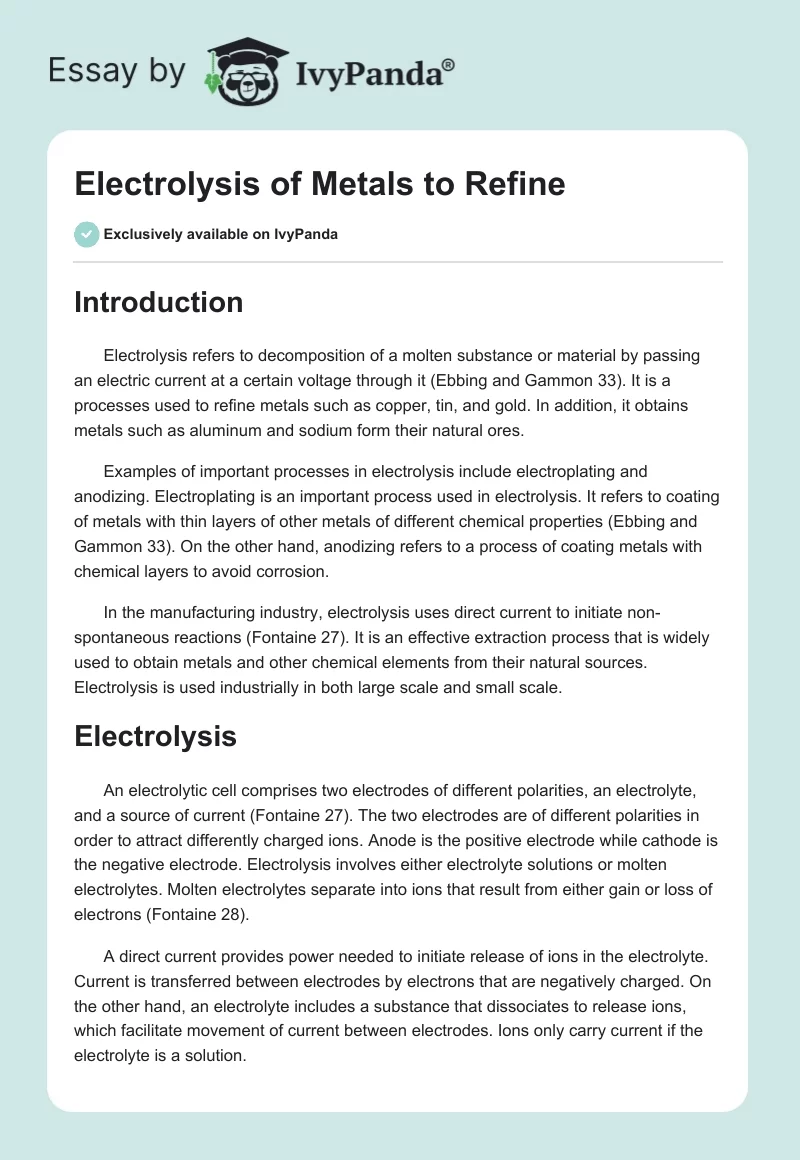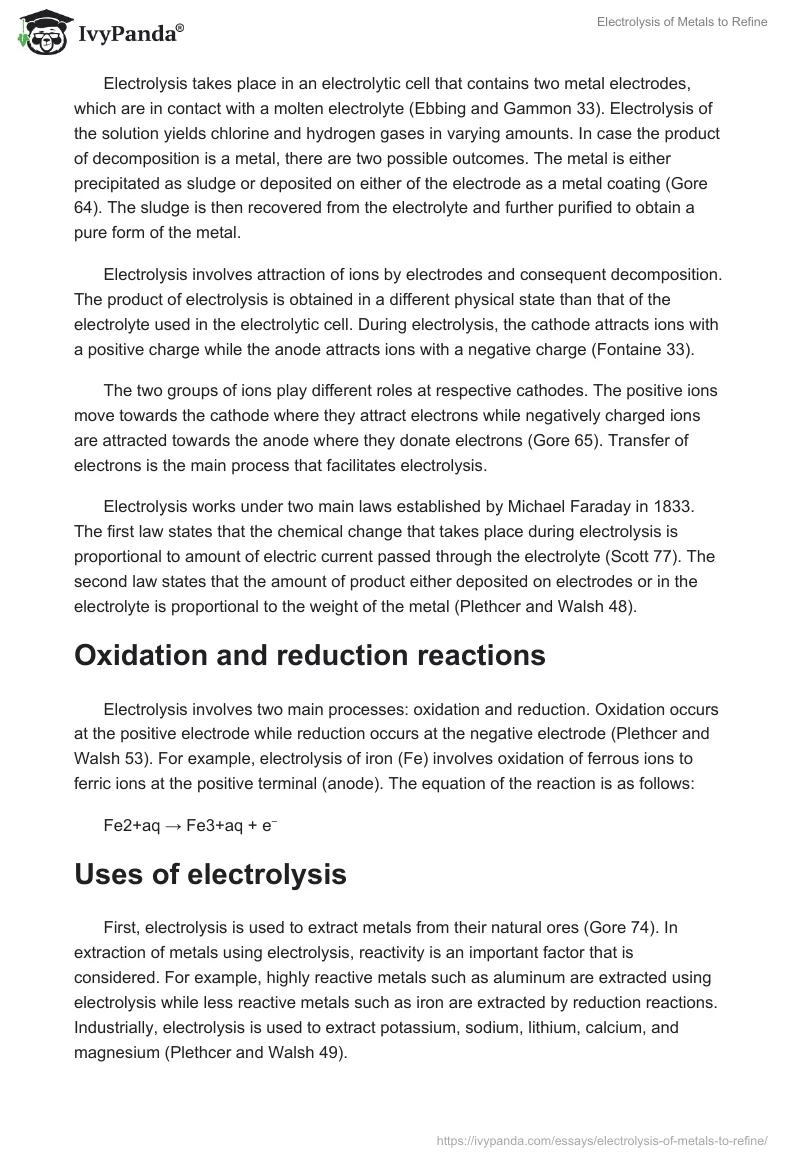Introduction
Electrolysis refers to decomposition of a molten substance or material by passing an electric current at a certain voltage through it (Ebbing and Gammon 33). It is a processes used to refine metals such as copper, tin, and gold. In addition, it obtains metals such as aluminum and sodium form their natural ores.
Examples of important processes in electrolysis include electroplating and anodizing. Electroplating is an important process used in electrolysis. It refers to coating of metals with thin layers of other metals of different chemical properties (Ebbing and Gammon 33). On the other hand, anodizing refers to a process of coating metals with chemical layers to avoid corrosion.
In the manufacturing industry, electrolysis uses direct current to initiate non-spontaneous reactions (Fontaine 27). It is an effective extraction process that is widely used to obtain metals and other chemical elements from their natural sources. Electrolysis is used industrially in both large scale and small scale.
Electrolysis
An electrolytic cell comprises two electrodes of different polarities, an electrolyte, and a source of current (Fontaine 27). The two electrodes are of different polarities in order to attract differently charged ions. Anode is the positive electrode while cathode is the negative electrode. Electrolysis involves either electrolyte solutions or molten electrolytes. Molten electrolytes separate into ions that result from either gain or loss of electrons (Fontaine 28).
A direct current provides power needed to initiate release of ions in the electrolyte. Current is transferred between electrodes by electrons that are negatively charged. On the other hand, an electrolyte includes a substance that dissociates to release ions, which facilitate movement of current between electrodes. Ions only carry current if the electrolyte is a solution.
Electrolysis takes place in an electrolytic cell that contains two metal electrodes, which are in contact with a molten electrolyte (Ebbing and Gammon 33). Electrolysis of the solution yields chlorine and hydrogen gases in varying amounts. In case the product of decomposition is a metal, there are two possible outcomes. The metal is either precipitated as sludge or deposited on either of the electrode as a metal coating (Gore 64). The sludge is then recovered from the electrolyte and further purified to obtain a pure form of the metal.
Electrolysis involves attraction of ions by electrodes and consequent decomposition. The product of electrolysis is obtained in a different physical state than that of the electrolyte used in the electrolytic cell. During electrolysis, the cathode attracts ions with a positive charge while the anode attracts ions with a negative charge (Fontaine 33).
The two groups of ions play different roles at respective cathodes. The positive ions move towards the cathode where they attract electrons while negatively charged ions are attracted towards the anode where they donate electrons (Gore 65). Transfer of electrons is the main process that facilitates electrolysis.
Electrolysis works under two main laws established by Michael Faraday in 1833. The first law states that the chemical change that takes place during electrolysis is proportional to amount of electric current passed through the electrolyte (Scott 77). The second law states that the amount of product either deposited on electrodes or in the electrolyte is proportional to the weight of the metal (Plethcer and Walsh 48).
Oxidation and reduction reactions
Electrolysis involves two main processes: oxidation and reduction. Oxidation occurs at the positive electrode while reduction occurs at the negative electrode (Plethcer and Walsh 53). For example, electrolysis of iron (Fe) involves oxidation of ferrous ions to ferric ions at the positive terminal (anode). The equation of the reaction is as follows:
Fe2+aq → Fe3+aq + e–
Uses of electrolysis
First, electrolysis is used to extract metals from their natural ores (Gore 74). In extraction of metals using electrolysis, reactivity is an important factor that is considered. For example, highly reactive metals such as aluminum are extracted using electrolysis while less reactive metals such as iron are extracted by reduction reactions. Industrially, electrolysis is used to extract potassium, sodium, lithium, calcium, and magnesium (Plethcer and Walsh 49).
Reduction by electrolysis is used to extract reactive metals. The process produces metals whose purity is higher than of metals extracted through other methods. However, it is an expensive process because it consumes a lot of electric power compared to other forms of metal extraction.
Second, electrolysis is used in anodization. Anodization is the process of creating an oxide coating on the surface of a metal in order to prevent corrosion (Plethcer and Walsh 54). The process is referred to as anodization because the metal or material to be anodized forms the anode. The process increases resistance to corrosion and wear. In addition, it increases the metal’s adhesion for paint and glues. Anodization alters the texture of the metal thus providing protection against rust. Commonly anodized metals include aluminum, titanium, zinc, magnesium, and tantalum.
Third, electrolysis is used in electrometallurgy. This refers to the process of reducing metals from metallic compounds in order to obtain their pure forms (Scott 83). It comprises four main categories of reactions that include electrowinning, electrorefining, electroplating, and electroforming. Electrowinning refers to the process of metal extraction from natural ores (Plethcer and Walsh 57). Electrorefining refers to the process of purifying metals.
Electroplating refers to the process of depositing a metal layer on another metal while electroforming refers to manufacture of metals by depositing metal layers on other metals (Plethcer and Walsh 58). Purification is necessary because impurities affect the chemical and physical properties of metals.
Electrolysis is used to purify metals obtained in impure form from their natural sources. For example, it is used to purify copper, which is obtained in an impure form from copper ores. In the process, copper electrodes are used. One of the electrodes is made of pure copper while the other is made of impure copper. When current is passed through the electrolyte, copper dissolves to release copper ions, which move to the cathode and are deposited as copper metal (Scott 84). Impurities are precipitated as sludge in the electrolyte.
Conclusion
Electrolysis refers to decomposition of a molten substance or material by passing an electric current through it at a certain voltage. It involves use of an electrolytic cell that has three main components: two electrodes, a direct current power source, and an electrolyte. Electrodes are of different polarities.
The electrolyte used must dissociate into ions in order to facilitate movement of current between electrodes. It is used for purification of metals, electroplating, and anodization. During the process, ions move for the electrolyte to electrodes depending on their charge. Electrolysis is the most appropriate method for extraction of certain metals because it obtains purer products than other methods.
Works Cited
Ebbing, Darrell, and Gammon Steven. General Chemistry. New York: Cengage Learning, 2009. Print.
Fontaine, Hippolyte. Electrolysis: A Practical Treatise on Nickeling, Coppering, Gilding, Silvering, the Refining of Metals, ad Treatment of Ores, by Means of Electricity. New York: HardPress, 2003. Print.
Gore, G. Electrolytic Separation, Recovery and Refining of Metals. New York: Watchmaker Publishing, 2003. Print.
Plethcer, David, and Walsh Franklin. Industrial Electrochemistry. New York: Springer, 2001. Print.
Scott, Keith. Electrochemical Processes for Clean Technology. New York: Royal Society of Chemistry, 2004. Print.


